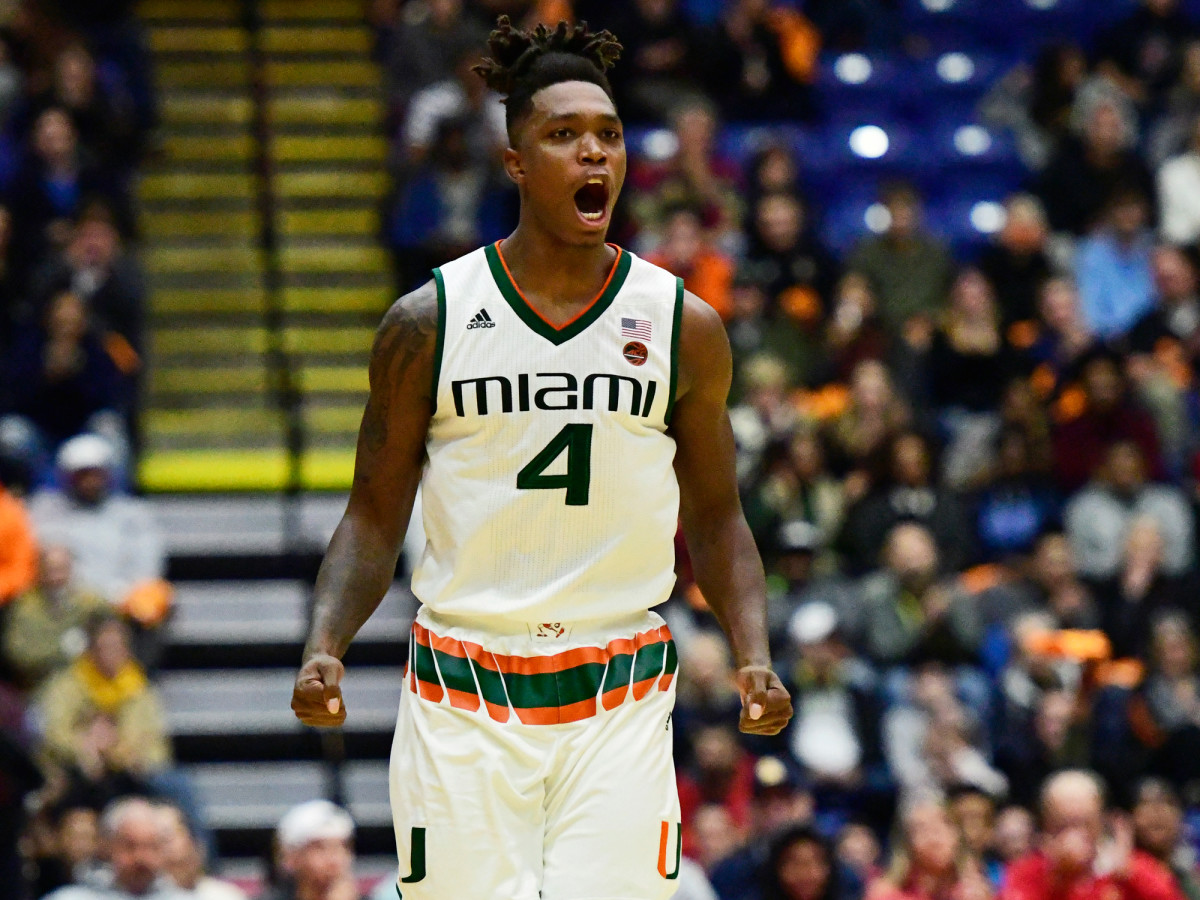Lonnie Walker Strengthens His NBA Lottery Case

The reasons Lonnie Walker IV was highly regarded as an NBA draft prospect before the start of his college basketball career are easy to identify. He was long and athletic. He was only 18 years old. He was one of the most esteemed shooting guards in his recruiting class. He had a track record as a big-time scorer and proficient three-point shooter. The outlines of a high-level three-and-D prospect were there. At Miami, Walker just needed to prove the mock drafts that placed him in the lottery were not off-base.
Walker has had a hard time doing that until recently because he wasn’t performing as well as his lofty preseason reputation suggested he would. After recovering from a torn meniscus suffered during a practice over the summer, Walker began 2017–18 coming off the bench. Over his first six games with the Hurricanes, Walker averaged only 6.8 points in 21 minutes per game and he eclipsed 13 points in a single game only once (in a blowout win over Patriot League opponent Boston University on Dec. 5) through mid-January.
Over the last three-plus weeks, the gap between Walker’s production and potential has narrowed, and an injury to one of his teammates should enable Walker to cement his status as one of the premier wing prospects in the 2018 class. Miami announced last week that sophomore guard Bruce Brown, a fellow first-round prospect whom The Crossover’s Front Office profiled in November, is expected to miss about six weeks after undergoing surgery to address a left-foot injury. That could sideline him until the beginning of the NCAA tournament.
Film Room: Breaking Down the Trae Young vs. Collin Sexton Matchup
In the meantime, Walker can help Miami cope by upping his offensive output. Walker’s scoring numbers had increased even before Brown went down. During a five-game stretch between a Jan. 7 meeting with Florida State and a Jan. 31 matchup with Pittsburgh, Walker averaged 19 points while shooting 45.7% on seven three-point attempts in 34.6 minutes per game and he was named the ACC Co-Rookie of the Week after putting up a combined 48 points on 17-of-33 shooting in overtime games against Louisville and Florida State.

“I see a player with a lot of raw physical talent and some unique skills,” Hurricanes coach Jim Larrañaga said after Walker went off for 25 points against the Cardinals, including a driving layup with only four seconds in regulation to force the extra session, during which he swatted a potential game-winning three-point attempt.
“But he’s only scratching the surface of how good he can become," Larrañaga continued. “There are a lot of things that he can add to his game. He’s very good now, but he can add a lot of dimensions to his game.”
Walker’s biggest asset at the next level could be his shooting ability. Opponents have to account for him if he’s spotting up behind the three-point line, and Walker’s quick release makes him more effective rising and firing off the dribble. Walker has knocked down 36.3% of his 102 attempts from deep this season, but he’s converting at a much higher clip over his last six games (44.4% on 7.5 attempts per game), and his improved shooting at the free throw line during ACC play (82.8%, though on only 29 attempts) bodes well for his development into a floor spacer at the next level.
Give Walker a few feet of breathing room once he crosses half court, and he won’t hesitate to let fly:
When he’s not burning defenses from distance, Walker can roast guys closing out on him by attacking off the bounce. He’s got a nice floater game, and he’s not easily fazed by frontcourt defenders around the basket. Although Walker doesn’t project as a go-to scoring option at the next level, he’s shined in a limited number of isolation situations this season, scoring more points per possession than all but one other player from the high-major conferences with a minimum of 10 such possessions (USC guard Jordan McLaughlin), according to data from Synergy Sports Technology.
In this sequence during the second half of a win over George Washington on Dec. 16, Walker uses a ball screen to knife into the lane, evade the defender that steps up to contest with an up-and-under move and toss in a one-handed layup.
Walker’s upside as a perimeter stopper is rooted in his combination of length and agility. Miami lists him at 6’5,’’ 204 pounds, but he has a reported wingspan of 6’10’’. Walker does well to move laterally to stay in front of ball handlers, and he may be able to guard positions one through three in the NBA, although Walker might not hold up physically against heftier perimeter players. In any case, Walker’s adaptability on that end of the floor would pair well with a defensively limited point guard who can’t credibly check the opponent’s most dangerous backcourt threat.
Walker is strengthening his case as a possible late lottery selection, but he’ll be evaluated on everything he’s done as a freshman, including that unremarkable stretch in the first half of the season, and he might ultimately top out at something closer to Norman Powell than Victor Oladipo. Among two-way wings, Villanova junior Mikal Bridges is more highly touted than Walker as a 2018 draft prospect, with Bridges placing ninth in The Front Office’s latest Big Board and 10th in its latest mock draft, compared to 12th and 19th, respectively, for Walker. Neither of those assessments took into account Walker’s recent surge, though.
Brown’s absence has opened the door for Walker to show what he can do. Whether or not he continues to take advantage of it, teams picking in the middle or late in the first round should be willing to take a chance on Walker because of his youth, physical tools and the league-wide shortage of wings who can shoot and defend multiple positions.
